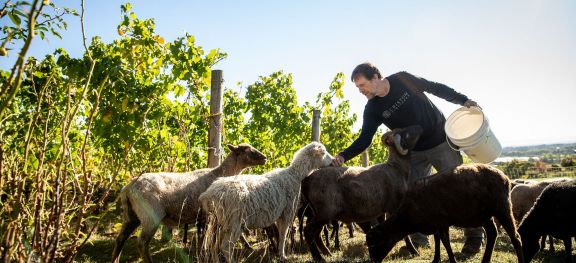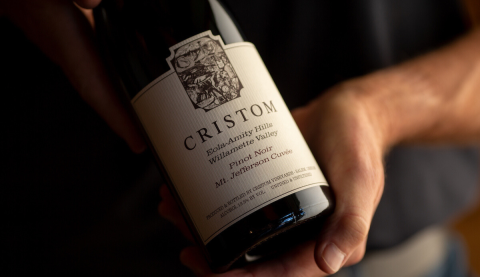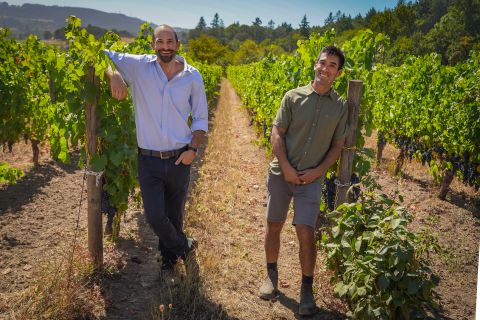Cristom, Mt Jefferson Cuvée Pinot Noir 2021 Eola-Amity Hills

Your new go-to wine for any day and any occasion. Above, assistant winemaker Andi Zorzi tending sheep in Cristom's biodynamically farmed vineyards. (Photo by John Valls.)
From $31.97, 369 Swedish kronor, HK$289, 445.01 Norwegian kroner, £36.30, 1,420 Taiwan dollars, €43.90, 349 Danish kroner, AU$110, SG$99
You know your go-to recipes? The ones that you pull out when you’re tired and you need something that always turns out right?
I have a list like that for wines. It is relatively short because wines that always deliver – no matter the vintage, no matter the age, no matter the occasion – are exceedingly rare.
One of the wines on this list is Cristom’s Cuvée Mt Jefferson Pinot Noir.
It’s a wine that I used to sell when I worked retail and on the floor of restaurants in Portland; it was my go-to for people who wanted an affordable local Pinot Noir. Drink now? Cellar it? Graduation? Promotion? Pasta Tuesday? No matter what the occasion, this wine can handle it. Over the years it’s gone up in price a touch – but it’s also gotten ever more impressive.
And in addition to being impressive, it captures what Willamette Valley’s wine industry is built on: community.
The Cristom story began in 1991 when Paul Gerrie decided that he’d attend Oregon’s International Pinot Noir Celebration (IPNC). Gerrie was obsessed with Burgundy, in love with Williams Selyem and Calera wines, and had a dream of growing world-class Pinot Noir.
At the IPNC, he met Michael Etzel, a cellarhand at Ponzi Vineyards who was starting a little project called Beaux Frères. Gerrie asked Etzel if he could hire him to find a few properties that were on the market. Etzel found two – the one that would become Gerrie’s Cristom (in what would later become Eola-Amity Hills) and one that would later become Shea Vineyard’s East Hill (in what would become Yamhill-Carlton).
Both properties were predominantly east facing and had elevations just below those of Gerrie’s beloved Burgundy. The choice was made for two reasons – the quality of the wine being made at a nearby property called Bethel Heights and the fact that Gerrie was intrigued by volcanic soils.
In 1992, Gerrie and his wife Eileen bought what is now Cristom from Mitchell and Beverly Mirassou. They retained the original 1982 plantings and began to plant more vines. And to make wine they hired Steve Doerner, Calera’s winemaker of 14 years.
Doerner had a wealth of knowledge from his tenure at Calera and the wines he made at Cristom convinced more than a few of the Willamette Valley’s current crop of winemakers to take up residency in Oregon. Doerner advocated the use of whole clusters and ambient fermentations, and he honed that craft until he began handing off Cristom’s winemaking responsibilities to Daniel Estrin (formerly of Littorai) in 2019.
As only the second head winemaker in the history of the estate, Estrin has already proved himself up to the task. With the support of the Gerries’ son, Tom, who took over estate management in 2012 and began transitioning the estate to biodynamic viticulture in 2017, Estrin has completed the transition to biodynamics and pulled soil health to the forefront. He has also considerably increased the focus of the white-wine programme.
The approach to the red-wine programme, Cristom’s strength for 30 years, has remained much the same. And the 2021 Mt Jefferson Cuvée, the flagship wine, is as good as ever (though the 2022 vintage, already available in the US, tops it – keep your eyes peeled for when it becomes available on export markets). As prices have soared throughout the Willamette Valley, Mt Jeff has retained its affordability and outclasses many wines double, and even triple, its price point.
The 2021 Mt Jefferson is light and fresh with the vibrant, tightly coiled acidity that is characteristic of the vintage alongside sweetly perfumed red and black fruit and a beguiling forest-floor earthiness. Cristom’s estate vineyard provided 52% of the fruit; the remainder came from grower partners throughout the Eola-Amity Hills. The fruit was all hand-harvested and hand-sorted, layered into tanks with 44% whole clusters, and was allowed to ferment spontaneously. After pressing, the wine was aged in 20% new oak for 11 months, resulting in a light spice that marries seamlessly with the fruit. It was then bottled unfined and unfiltered.
Owing to this producer’s relatively long history and outstanding quality, the wines are well represented internationally. As well as being widely available across the US, this particular cuvée can be found in the UK (from VINVM, Stannary Wine, The Good Wine Shop, Vin Cognito and Philglas & Swiggot), Spain, Portugal, France, Belgium, Italy, Norway, Denmark, Sweden, Hong Kong, Singapore, Taiwan and Australia.
All photos courtesy Cristom Vineyards.
Members can find another 600+ Willamette Valley wine recommendations in our tasting notes database.
Become a member to view this article and thousands more!
- 15,427 featured articles
- 274,507 wine reviews
- Maps from The World Atlas of Wine, 8th edition (RRP £50)
- The Oxford Companion to Wine, 5th edition (RRP £50)
- Members’ forum
- 15,427 featured articles
- 274,507 wine reviews
- Maps from The World Atlas of Wine, 8th edition (RRP £50)
- The Oxford Companion to Wine, 5th edition (RRP £50)
- Members’ forum
- Commercial use of our Tasting Notes




